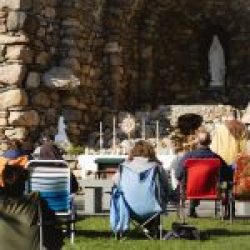“The Holy Spirit is at work in the church calling all people, some young and some older, to vocations.“
With these words, Fr. Mark Kaminski, the director of diocesan deacon formation, describes the underlying intent of vocations awareness; everyone has a calling. “That’s the joy of the Holy Spirit, that people in every age are being called,” he adds.
With responsibility specifically for vocations to the permanent diaconate, Father Kaminski is hyper focused on the unique dimension of diaconal vocations.
“That’s one of the misunderstandings of Vatican II, that people think we revived the diaconate due to the shortage of priests…that’s absolutely not true.” Fr. Kaminski stresses that the modern charisms of the deacon compliment what priestly ministry entails. It was intended that way from the beginning of the order. “This is from the very beginning of Christianity as we know it. There was a need for this specific ministry and there is a beautiful description of why they came to this conclusion in the Acts of the Apostles (see Acts 6:1-7).”
The first deacons were called to assist the physical needs of a growing community, to provide charity to those in need. Their role expanded to address the spirit of the call as well. “That ministry of providing for the temporal and the spiritual needs of the people still remains, at its very core, the same,” adds Fr. Kaminski. “It still remains that deacons are providing for the needs of the people, of the community.”
Locally and nationally, vocations to the permanent diaconate go against the trends that have challenged vocations to the priesthood and religious life. A 2021 study by the Center for Applied Research in the Apostolate shows that since 1975, the numbers of priests, religious sisters and brothers have dropped 40% to 70%, depending on the category. In that same time period, which marks the early years of the reinstatement of the permanent diaconate, numbers swelled from about 900 in 1975 to over 18,000 in 2020.
Deacons are relied on more and more today in parish leadership, chaplaincy, and a host of other ministries. Fr. Kaminski adds that, in many ways, the deacon may be more connected to the pulse of the community than a priest, only because of the nature of the vocation. The majority of deacons are married, may have children and grandchildren, and likely worked in secular careers before coming to the vocation later in life.
Fr. Kaminski welcomes those feeling a potential call to explore the vocation. “We are looking at applicants one by one and assisting men of all ages in discerning the vocation. We are cooperating with the Holy Spirit!”
“We meet people where they are.”







